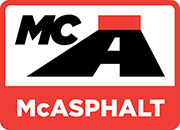Coloured Slurry
Coloured slurry is a mixture of synthetic emulsion binder, pigments and specially selected aggregates. Coloured slurry is quick to set, can be produced in almost any colour and creates a durable, attractive wearing surface with excellent skid resistance. Uses include lane delineation, shoulder delineation, decorative medians, crosswalks, driveways, golf cart paths, bike paths and turn lanes.
Design Criteria
When designing a coloured slurry seal a number of factors have to be examined and assessed to ensure a proper surface will be placed that satisfy the requirements. The following factors can have a tremendous effect on the performance of the slurry seal; traffic, aggregate type and colour, existing surface and residual asphalt content. The colour and shade of the slurry seal has to be established with the client. Due to the existing road conditions and traffic will there be one lift or two lifts of slurry. If these factors are addressed the chances of a good coloured slurry seal being placed are greatly increased.
Materials
Asphalt Emulsions:
The emulsion used in coloured slurry can be of two types; regular type slurry emulsion or a special resin based product. With the regular type slurry emulsion (CQS-1H) the coloured dyes that can be used are limited to the earth tone types. The dyes are typically in powdered form and are added as fillers. The resin type emulsion is specially formulated (usually contains some polymers) and can be used with many different coloured dyes. The dyes are typically in liquid form.
Aggregate:
The aggregate used are the same aggregates used in conventional slurry seal or can be specialty type aggregates that are the same colour as the coloured dye. The same physical properties that are required for the conventional slurry seal are needed for the coloured slurry.
Performance Guidelines
In order to construct a proper well designed coloured slurry seal the following guidelines should be followed:
- Design a slurry seal with aggregate to be used on job
- Establish how the dye will be added to seal
- Use a well graded screenings
- Establish the colour and shade of colour desired
- Ensure compatibility of aggregate and emulsion
- Calibrate and inspect all equipment
- Follow proper construction techniques
- Use traffic control to protect seal
- Work only in weather suitable for type and grade of emulsion being used
